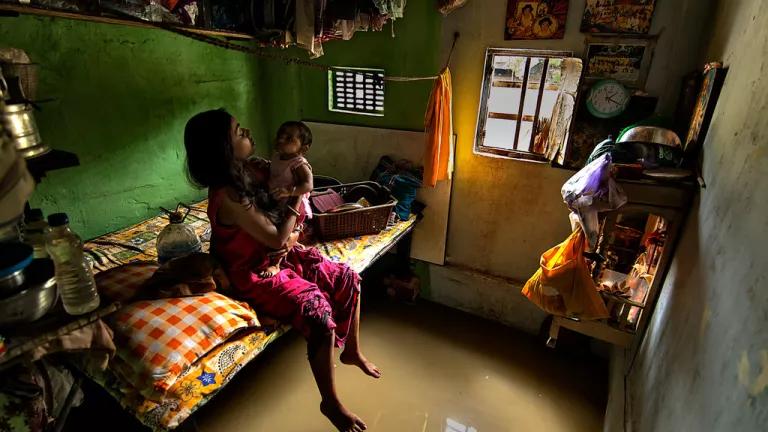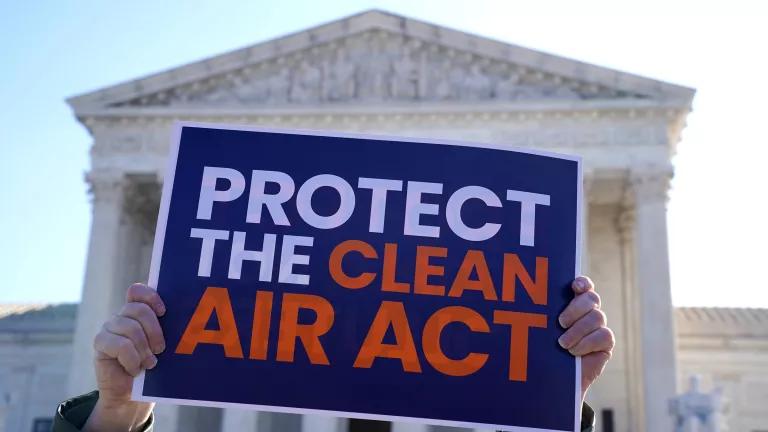A Nation Broils: Fund the American Jobs Plan for the Climate Action We Need
Summer is just beginning, and it’s already made this much clear: The time for climate action is now.

People rest at a cooling center in Portland, Oregon, on June 28, 2021.
Summer is just beginning, and it’s already made this much clear: The time for climate action is now.
On Monday, one of the hottest places on the planet was Portland, Oregon, where record temperatures of 116 degrees caused streets to buckle and sent scores of people to area emergency rooms for heat-related illness. Cloud City Ice Cream was closed—due to heat.
In nearby Seattle, where temperatures normally top out at around 74 degrees this time of year, it was a record-breaking 108. The next day, a few hours drive north, it was 121 degrees in the Canadian town of Lytton, exceeding that nation’s previous all-time high by a breathtaking 8 degrees.
By Friday, record-shattering heat had contributed to the deaths of nearly 100 people in the states of Oregon and Washington, combining with the worst drought in at least 20 years across the American West to highlight, once more, the rising costs and mounting dangers the climate crisis is inflicting on our families, health, communities, and farms.
It’s not only part of the country that’s reeling. Climate change is wreaking havoc nationwide, bringing hotter temperatures and making heat waves, floods, drought, and other extreme weather events both more frequent and increasingly devastating.
Epic flooding forced Vice President Kamala Harris to scrub a planned visit this week to Detroit, where abandoned cars floated down freeways in the heart of Motor City. Maine just wrapped up its hottest June on record, part of a scorching heat wave across the Northeast. And on Friday, residents of South Florida, still grieving the tragic collapse of an oceanfront condominium tower, were anxiously eyeing the path of Hurricane Elsa, as the fifth named storm of this hurricane season roared up the Caribbean.
Summer is just beginning, and it’s already made this much clear: The time for climate action is now.
The single-most important step we can take, as a nation, is for Congress to fully fund President Biden’s vision for an American Jobs Plan, a comprehensive package of strategic investment that drives equitable recovery with climate action at a moment when the nation urgently needs both.
The American Jobs Plan will enable us to revitalize the nation’s bridges and roads, bring broadband internet service to rural communities, and clean up our dirty power plants. By doing all that, while speeding the shift to electric vehicles, capping abandoned oil and gas wells, and addressing other critical priorities, the American Jobs Plan will create millions of good-paying jobs and strengthen U.S. competitiveness.
The bipartisan infrastructure package that key U.S. senators agreed to last week takes us partway there, but it stops far, far short of providing the climate action and investments we need. Now Congress needs to finish its work and fully fund the American Jobs Plan, so we can get our people back to work and confront the climate crisis—while we still have time.
The American Jobs Plan is the climate plan the country needs.
It will set the nation on track to cut the carbon pollution from burning fossil fuels in half by 2030, and to stop adding it to the atmosphere altogether by 2050. That’s what the science says we must do, globally, to avert full-on climate catastrophe.
Across much of the American West, we’re getting a hellish look at where our failure to act so far has brought us, with tens of millions of people paying the price on the frontlines of the widening climate crisis.
The atmospheric heat dome that blanketed the Pacific Northwest last week is linked to rising temperatures in the Arctic, which is warming twice as fast as the global average. Climate change is making heat waves in general more common, extending the number of especially hot days each year nationwide.
Warming temperatures are contributing to the kind of extended drought that’s drying out the West. And the blazing heat and dry conditions have set the table for what experts fear could be a devastating wildfire season. States like California and Colorado, both of which suffered record wildfire seasons last year, are bracing for the worst.

A firefighter battles the Bond Fire in Orange County, California, on December 3, 2020.
“In fact, the threat of western wildfires this year is as severe as it’s ever been,” President Biden said Wednesday, during a wildfire preparedness meeting with key cabinet members, governors from eight western states, and regional power company executives.
“Fire season, traditionally, lasts through October,” he explained. “But, with climate change driving the dangerous confluence of extreme heat and prolonged drought, we’re seeing wildfires in greater intensity that move with more speed” and an extended fire season, said Biden, who pledged federal assistance to help address a critical shortage of wildfire fighters.
The West hasn’t been this dry in at least two decades, with 82 percent of the region experiencing severe drought. Indigenous peoples have been among the hardest hit: tribal lands are experiencing severe drought in places like southern Oregon, northern California, and parts of Arizona and Colorado.
Across much of the region, water use is being increasingly restricted. Fishing has been limited in parts of Montana, Colorado and elsewhere, as water temperatures rise and water levels fall.
Lake Mead, a key man-made reservoir for the Colorado River, hasn’t been this low since it was filled before World War II. Water in California’s two largest reservoirs—lakes Shasta and Oroville—has fallen to less than half the normal level for this time of year, and some are in even worse shape. California’s snowpack—a perennial source of summer water—no longer even registers as a percentage of normal levels. It is, statistically speaking, gone.

Pipes from an abandoned water intake tower on Pyramid Island, which is no longer surrounded by water, extend out at Lake Mead on June 12, 2021.
And then there’s the heat, which sent more than 1,100 people to emergency rooms last week in the states of Oregon and Washington.
The frequency of heat waves has tripled over the past 50 years, occurring at least six times a year, on average, over the past decade. That’s up from twice per year in the 1960s. Across 50 major U.S. cities, the average heat wave season is 47 days longer.
Extreme heat is one reason why the health costs of climate change and air pollution top $800 billion a year—and rising—across the country.
Heat exhaustion is a serious condition that can require emergency medical treatment, as is heat stroke, which, in severe cases, can be deadly. Extreme heat can be especially dangerous to those with existing conditions like diabetes, heart disease, or respiratory ailments.
Extreme heat can put older adults, in particular, at risk of serious illness and even death, as the heart works harder to try to regulate body temperatures. People who live in low-income communities can be especially vulnerable, often due to a lack of air conditioning or a place to get out of the heat. And farmworkers, construction workers, and others who work outside can be exposed to the heat for extended periods of time, again, increasing the risks to health.

A person holds up a photo of Sebastian Francisco Perez, 38, who died while working at an Oregon plant nursery under extreme heat conditions on June 26, 2021.
Humans aren’t the only ones suffering. Iconic species are being driven to the brink.
In Oregon, the blistering heat and withering drought are stressing Douglas fir trees, stunting their growth and weakening their defenses against bark beetles and other pests. In Washington state, officials fear a grim repeat of 2015, when half the run of spawning sockeye salmon were killed by warm waters in the Columbia and Snake rivers. Across parts of California, rattlesnakes are showing up in potted plants and bears are wandering community playgrounds as parched wildlife edges further into suburbia in search of food and water.
The impact could soon show up in grocery prices.
Drought is leaving croplands parched in areas that produce more than 90 percent of the country’s spring wheat and durum wheat, support 57 percent of U.S. dairy cattle, and 38 percent of the nation’s corn production. In parts of California, almond farmers are bulldozing trees for lack of water. Fields that normally would be planted with strawberries, lettuce, and cauliflower are lying fallow for lack of water.
“Are we going to be able to farm here?” wondered Sara Tashker, who’s farmed outside of San Francisco for nearly two decades, to Bloomberg Green, an environmental news service. “Is there going to be enough water? Are we going to be able to adapt? Is it going to be too dangerous to live in these fire ecosystems? Is this just going to become too expensive?”
For millions of Americans like Sara, climate change is already forcing existential questions. All of this, and much more, will get worse, the science tells us, unless we act now to protect our future. The American Jobs Plan is the single-strongest step we can take toward doing exactly that. Congress must fully fund this needed plan—and now.



